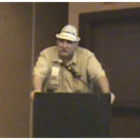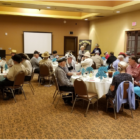Roundup: November 2021
Roundup Synopsis
Taken from the Fall 2021 Branding Iron.
In November, we all traded our Stetsons for silly hats, as Crazy Hat Night descended upon Almansor Court. As usual, three standouts were chosen to take home prizes in honor of their daring fashion sensibilities. Mike Johnson had family to thank for his absurdly tall rainbow squid hat. Hal Eaton donned a bovine beauty, complete with twitching ears, and Dorothy Mutz looked lovely and over the top in her rose-covered cartwheel. Thanks to everyone who threw caution to the wind and sailed the silly seas. I would like to take this opportunity to buck for the next Crazy Shirt Night to come soon!
The evening’s presentation was given by a trilby-clad Mark Mutz (clearly, his better half had more hat mojo working that evening). Mr. Mutz took us on a journey through some of the area’s communities, exploring their beginnings as “irrigation colonies” created by Canadian-born developer George Chaffey.
George Chaffey was a man who understood that land without water wasn’t worth much. As such, when he sought to sell parcels of land in his first development, Etiwanda, the water rights were inexorably tied to the land. Each parcel could be sold and transferred as any other, but its right to water always went with it. This practice led to a far less murky and litigious environment than the one it succeeded. Its “water corporation” concept quickly became the standard system of distribution for water rights in California.
The success of the Etiwanda colony led Chaffey and Holt to purchase 6,216 more acres nearby, for what would become Ontario. This colony was founded with four guarantees: water rights for every land owner, a construction plan for beautiful Euclid avenue, a planned college of agriculture— which later became Chaffey High School, and a prohibition against alcohol. These tenets struck a resounding chord in line with the mores of the burgeoning progressive movement, and Ontario’s parcels sold well, marking another successful venture for Chaffey hot on the heels of his first.
Not all of Chaffey’s endeavours would meet with the same success as Etiwanda and Ontario, however. There was his failed bid to plot the Werribee River valley in Australia, scuttled by drought, a banking crisis, and Chaffey’s construction of a fancy home for himself while most investors were struggling to make use of their land. Manzanar, though not a fiscal failure, never thrived as a colony because it was purchased entirely by Los Angeles, and is now best known as the site of the infamous WWII Japanese internment camp. Another project truly did end in disaster, though not entirely due to Chaffey’s actions. That was his diversion of part of the Colorado River to irrigate the Imperial and Coachella Valleys and the Salton Sink. Heavy rain and runoff destroyed a relief canal, causing a flood that damaged large amounts of property, and led to not only a lawsuit by Southern Pacific, but to formation of the Salton Sea as we see it now.
In all, an entertaining evening that was kicked off by some hilarious headwear was capped by Mark’s fascinating portrait of one of our region’s less-well-known early developers. We were all reminded that one’s name needn’t have been Griffith, Doheny, or Huntington to have mattered to the creation of our humble little corner of the state. See you all on Crazy Shirt Night, whenever that may be.
— Alan Griffin





